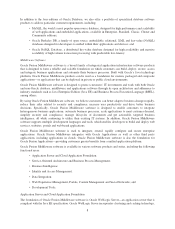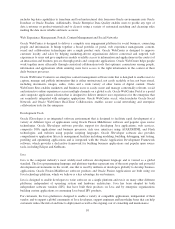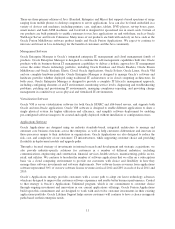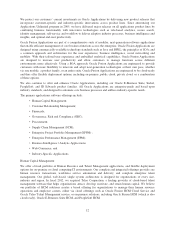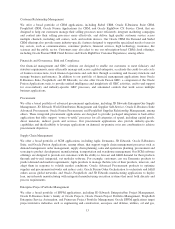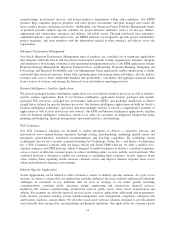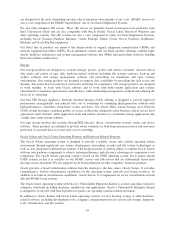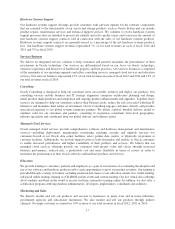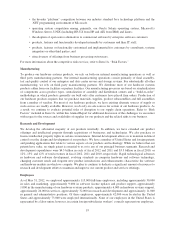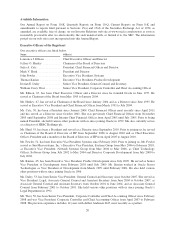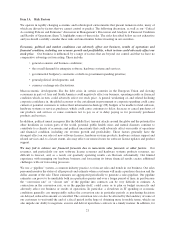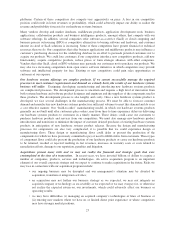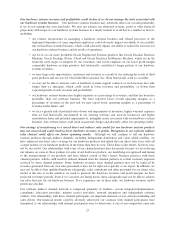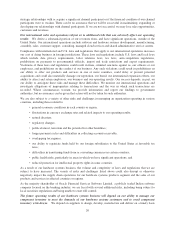Oracle 2012 Annual Report Download - page 22
Download and view the complete annual report
Please find page 22 of the 2012 Oracle annual report below. You can navigate through the pages in the report by either clicking on the pages listed below, or by using the keyword search tool below to find specific information within the annual report.In the United States, our sales and service employees are based in our headquarters and in field offices
throughout the country. Outside the United States, our international subsidiaries sell and support our products in
their local countries as well as within other foreign countries where we do not operate through a direct sales
subsidiary. Our geographic coverage allows us to draw on business and technical expertise from a global
workforce, provides stability to our operations and revenue streams to offset geography-specific economic trends
and offers us an opportunity to take advantage of new markets for our products. Our international operations
subject us to certain risks, which are more fully described in “Risk Factors” included in Item 1A. of this Annual
Report. A summary of our domestic and international revenues and long-lived assets is set forth in Note 16 of
Notes to Consolidated Financial Statements included elsewhere in this Annual Report.
We also market our products worldwide through indirect channels. The companies that comprise our indirect channel
network are members of the Oracle Partner Network. The Oracle Partner Network is a global program that manages our
business relationships with a large, broad-based network of companies, including independent software and hardware
vendors, system integrators and resellers that deliver innovative solutions and services based upon our products. By
offering our partners access to our premier products, educational information, technical services, marketing and sales
support, the Oracle Partner Network program extends our market reach by providing our partners with the resources
they need to be successful in delivering solutions to customers globally. The majority of our hardware systems products
are sold through indirect channels including independent distributors and value added resellers.
Seasonality and Cyclicality
Our quarterly revenues have historically been affected by a variety of seasonal factors, including the structure of
our sales force incentive compensation plans, which are common in the technology industry. Our total revenues
and operating margins are typically highest in our fourth fiscal quarter and lowest in our first fiscal quarter. The
operating margins of our businesses are generally affected by seasonal factors in a similar manner as our
revenues (in particular, our new software licenses segment) as certain expenses within our cost structure are
relatively fixed in the short term. See “Selected Quarterly Financial Data” in Item 7 of this Annual Report for a
more complete description of the seasonality and cyclicality of our revenues, expenses and margins.
Competition
We face intense competition in all aspects of our business. The nature of the IT industry creates a competitive
landscape that is constantly evolving as firms emerge, expand or are acquired, as technology evolves and as
customer demands and competitive pressures otherwise change.
Our customers are demanding less complexity and lower total cost in the implementation, sourcing, integration and
ongoing maintenance of their enterprise software and hardware systems. Our enterprise software and hardware
offerings compete directly with some offerings from some of the largest and most competitive companies in the
world, including Microsoft Corporation (Microsoft), International Business Machines Corporation (IBM), Intel,
Hewlett-Packard Company (HP) and SAP AG, and smaller companies like Salesforce.com, as well as many others.
In addition, the low barriers to entry in many of our market segments regularly introduce new technologies and new
and growing competitors to challenge our offerings. Our competitors range from companies offering broad IT
solutions across many of our lines of business to vendors providing point solutions, or offerings focused on a
specific functionality, product area or industry. In addition, as we expand into new market segments, we will face
increased competition as we will compete with existing competitors, as well as firms that may be partners in other
areas of our business and other firms with whom we have not previously competed. Moreover, we or our
competitors may take certain strategic actions—including acquisitions, partnerships and joint ventures, or
repositioning of product lines—which invite even greater competition in one or more product categories.
Key competitive factors in each of the segments in which we currently compete and may compete in the future
include: total cost of ownership, performance, scalability, reliability, security, functionality, efficiency, ease of
management and quality of technical support. Our product sales (and the relative strength of our products versus
those of our competitors) are also directly and indirectly affected by the following, among other things:
• the adoption of SaaS, hosted or cloud software offerings;
• the adoption of commodity servers and microprocessors;
18


